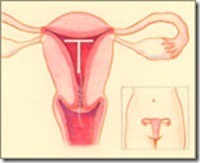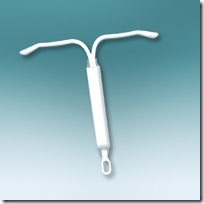An IUD (intrauterine device) is a small, coin-sized object shaped like a T with a string attached to it which hangs out the uterus. It is inserted through the cervix into the uterus as a method of birth-control or a method of emergency birth-control. It is put in place by a doctor and is also removed by a doctor when it has reached it's expiry date or when you choose to have it removed. The IUD works by preventing the sperm from joining with  an egg and changes the lining of the uterus so that implantation can not occur. There are two types of IUD's:
an egg and changes the lining of the uterus so that implantation can not occur. There are two types of IUD's:
The copper IUD:
The copper IUD is a T-shaped piece of plastic which is covered in a think coil of copper. Copper is toxic to sperm, with the copper T your uterus and fallopian tubes create a fluid which kills sperms. The copper IUD can last between 10 to 12 years but it is suggested that you use the same one for no longer than 10 years. The copper T is a highly effective form of birth control with a failure rate of less than 1%. The copper T is a better choice if you are breastfeeding.
This is a hormone based IUD. It releases hormones for up to 5 years which kill or damage sperm. It makes the mucus in the cervix thick and sticky so that sperm can not enter into the uterus. It also keeps the uterus lining thin so that a fertilized egg can not implant and grow. The Mirena IUD is slightly more effective than the copper T and it also decreases the chances of pelvic inflammatory disease. The Mirena can regulate your menstrual cycle, decrease the amount of bleeding and relieve menstrual cramps.
The risks and disadvantages:
- Increased menstrual bleeding and spotting between periods, this only occurs in 12% of woman using IUD's. This only lasts three months with the Mirena and then periods almost disappear completely.
- 1 in 1000 woman will experience a punctured uterus which only occurs during insertion. The IUD must be removed immediately if this occurs. 1 in 1000 woman experience the IUD getting stuck in the uterus.
- Although extremely rare, the IUD may puncture the uterus after insertion and if left untreated may become embedded in the uterus wall. This will require surgery to be removed and may cause you to become sterile.
- About 2 to 10% of IUD's are expelled from the uterus. When this happens you are no longer protected from pregnancy.
- Pelvic inflammatory disease (PID). This can be quite painful and uncomfortable but will clear up with a course of anti-biotics.
- No protection against sexually transmitted infections.
Insertion:
An IUD is inserted by a doctor. You might have a local anaesthetic but it is often unnecessary especially for woman who have had a vaginal childbirth in the past. Your doctor will do an ultrasound on your uterus to make sure it is in the right place. After insertion you may experience some cramping and spotting for the next two days.
When not to get an IUD:
- If you currently have an STD or have had one in the past 3 months.
- You do not want to use condoms to protect you from STD's
- If you have an active infection of your cervix or vagina
- If you have PID or have recently suffered from PID
- If you have a history of problems with IUDs
- If you have abnormalities of your uterus
- If you have an allergy to copper
Make sure you do not have any vaginal infections when getting your IUD inserted as the infection may spread to your uterus. Check that the string is still in place after every menstrual period. Get all the information from your doctor before getting the IUD inserted. If you experience any pain or heavy bleeding after insertion consult your doctor immediately.

No comments:
Post a Comment